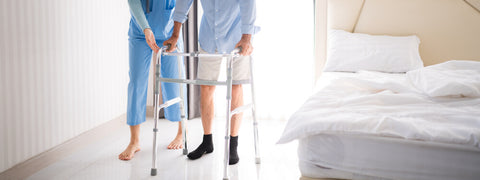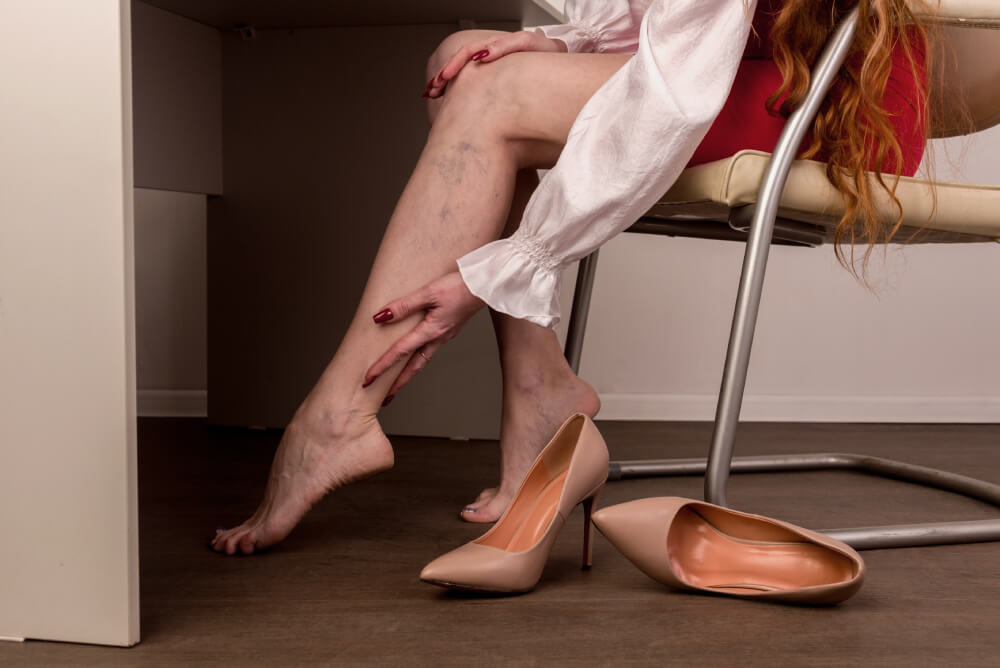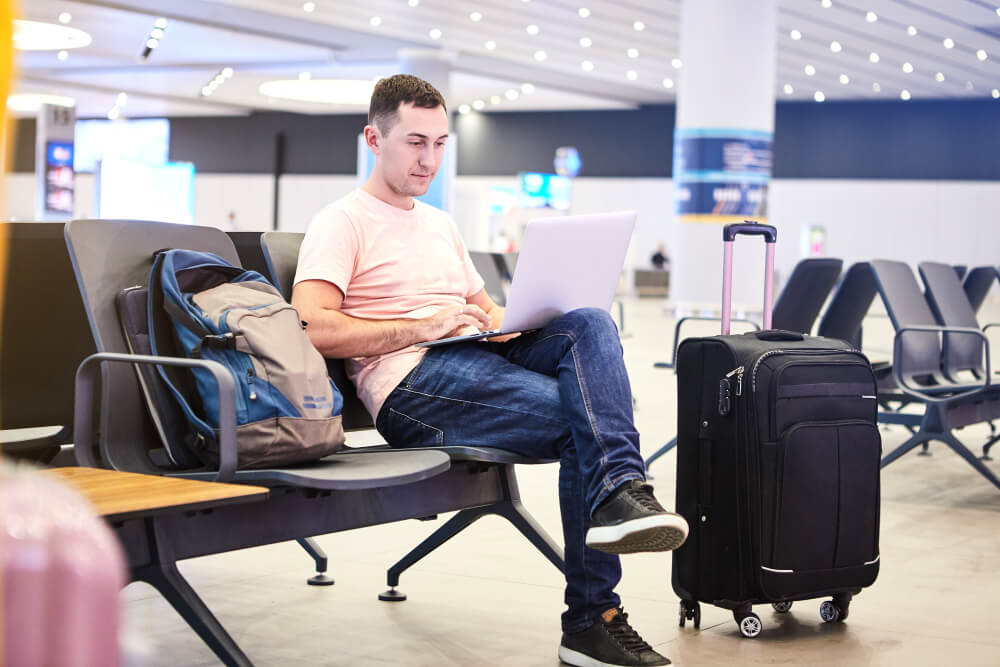

Featured Products
-
Example product title
Regular price $19.99Regular price Sale price $19.99Unit price -
Example product title
Regular price $19.99Regular price Sale price $19.99Unit price -
Example product title
Regular price $19.99Regular price Sale price $19.99Unit price -
Example product title
Regular price $19.99Regular price Sale price $19.99Unit price
Anyone who has taken a flight knows how cramped and tiny the cabin is. Even short trips might seem unpleasant and drawn out because of these chairs, designed with little room for our legs. Your legs may start to feel numb or restless after sitting. Tall folks may find this much more difficult.
Swelling feet and legs during a lengthy journey is not unusual but painful. Leg veins typically struggle to return blood to the heart when confined to one area for extended periods and cannot move about significantly. Your lower legs may experience pressure and edema as a result of this. Compression socks for air travel may help with that, particularly on lengthy trips.
Let's get to know more about them in detail!
Knowing About Types of Compression Socks
Compression socks are clothing items that tighten and increase blood flow in your feet and calves. Also, these socks are primarily divided into three categories.
-
Graduated Compression Socks
Gradient compression socks exert pressure at the ankles to promote circulation. The socks become progressively less restrictive as they go up your leg. A prescription and an expert fitting are usually needed to find the best compression socks for flying. Typically, they are made to be as flexible, strong, and long as required by medical requirements.
-
 Non-Medical Support Hosiery
Non-Medical Support Hosiery
Comparing non-medical support socks to graded compression socks, the former are meant to be more rigid. They are easily available in shops and online and don't need a prescription. Non-medical support hosiery is intended to promote circulation and relieve tired legs.
-
Anti-Embolism Socks
The purpose of anti-embolism socks is to stop deep vein thrombosis (DVT). These socks come in a range of compression levels. Anti-embolism socks are often designed for those with restricted movement. Like graded compression socks, these socks may only be bought with a prescription.
Why Compression Socks for Flights?
Understanding the functioning of compression socks is crucial to appreciating their aviation needs. Extended periods of sitting may cause blood to pool in your feet. This may result in soreness and edema. Compression socks counteract the effects of gravity by applying pressure to your feet, which causes blood to flow to your toes. They keep you comfy and enhance your circulation. Considering that you won't be moving too much when you're in the air, this is really crucial.
-
Preventing Blood Clots
Long periods of sitting on airplanes might raise your chance of causing deep vein thrombosis (DVT), a dangerous illness in which blood clots form in the legs. Compression socks may help lower this risk on extended flights by encouraging healthy blood flow.

-
Cut Down on Leg Swelling
Improving blood circulation is one of the main advantages of flight socks. They avoid swelling and pain by stopping blood from building up in the legs and feet.
-
Coziness and Assistance
These socks not only improve health but also provide extra leg support. Long-haul flight tiredness and the development of cramps may both be considerably lessened with this assistance.
-
Quicker Recuperation After Travel
Compression socks may be useful even after takeoff for those who need to get back on their feet quickly, whether for business or adventure. They help you regain your feet faster and with less stiffness by speeding up the muscle-healing process.
When to Wear Compression Socks During Travel?
Compression socks are a great option for travelers since they are designed to increase circulation. Long excursions are a great time to reap its advantages. Here's a tutorial explaining when to use compression socks while flying and how to use them:
-
 Before Your Trip :
Before Your Trip :
It's a good idea to put on your compression socks before you leave for your destination. This guarantees that by the time you start your trip, you'll already be enjoying the advantages, particularly if you have a long distance to go to reach the airport.
-
During the Flight :
Consider wearing compression socks if you're on a long flight. They aid in mitigating the negative effects of prolonged sitting and inactivity.
-
Following Arrival :
If your journey was lengthy, you may want to keep your compression socks on for a few hours after arrival. This may help minimize any possible edema and enhance leg comfort.
Steps on How to Put on Compression Socks
It might help to become used to putting on compression socks before your trip. Since airline cabins are small, it's best to practice at home so you'll be ready and at ease when it comes time to wear them on a trip.
Here are a few easy actions to do:
- First, confirm that your compression socks are the appropriate size. A snug fit is what they should have, but not too snug or unpleasant.
- Taking a comfortable seat, place your toes flat on the ground.
- Insert your foot into the toe section of the sock after turning it inside out.
- Smooth any creases or wrinkles on the sock as you slowly bring it up near your knee.
- Make sure the socks are spread uniformly and aren't bundled up in any one area after they are pushed up too close to your knee.
- For the opposite leg, follow these procedures again.
Taking Care of Your Compression Socks
The following advice will help you wash and maintain your compression socks for air travel properly:
-
Hand Wash or Use a Gentle Cycle
It is not recommended to wash compression socks in either cold or hot water, as this might cause the fabric's elasticity to be damaged. Alternatively, consider using a soft cycle in your washing machine or washing your socks in lukewarm water with a light detergent. Since fabric softeners and bleach may harm the material, avoid using them. -
Do Not Wring Out
Don't wring out your compression socks while they're drying. Just use a towel to blot or squeeze out any remaining water, then hang them to dry inside or outdoors (out of direct sunlight). Steer clear of tumble drying, which might weaken the sock's structure and diminish its efficacy.
-
Keep Them Stored Correctly
Your compression socks for air travel should be kept in a cool, dry area after drying. They may be rolled up into a ball or folded neatly, but do not leave any wrinkles in the cloth as this may compromise the fit and comfort. You can ensure your compression socks keep their efficacy and continue to provide long-lasting advantages for years by following these easy instructions for cleaning and caring for them.
Factors to Consider When Selecting Compression Socks
When choosing compression socks for your next flight, ensure you have weighed important factors that ensure these socks will be to your liking in terms of comfort and effectiveness. Keeping these basic factors in mind will allow you to select the best compression socks for flying:
-
Compression Level
millimeters of mercury (mmHg). Compression levels dictate how tight-fitting these articles of legwear will be, and typically range from mild (8-15mmHg) to moderate (15-20 mmHg), firm (20-30 mmHg) with extra firm (30-40 mmHg) being the highest. Compression socks come in different compression levels, usually measured in.
-
Size and Fit
Proper sizing is important to compression socks' effectiveness and comfort. They should fit snugly but not be too tight so they stay in place without squeezing your legs and causing discomfort. Many brands have sizing charts with calves' measurements and shoe sizes. Additional factors to consider may include the length of the socks and whether any accommodate different calves of different sizes to fit a wider variety of people.
-
Material
Compression socks are made from nylon, spandex, polyester, and natural fibers such as cotton or merino wool. Each material has its perks. This depends on how well it breathes, wicks away moisture, is durable, and comfortable. For flying, you might choose fabrics that wick away moisture and are breathable. This will keep your feet dry on long flights. On the other hand, if your skin is sensitive or prone to allergies, look for hypoallergenic materials which won't bother you.
-
Durability
Compression socks are meant to be used repeatedly, especially while traveling--therefore, durability is a critical concern. Look for socks made from top-quality materials with reinforced seams and tough construction that require frequent washing and wear. Check what customers say about each brand's durability when buying compression socks for air travel.
